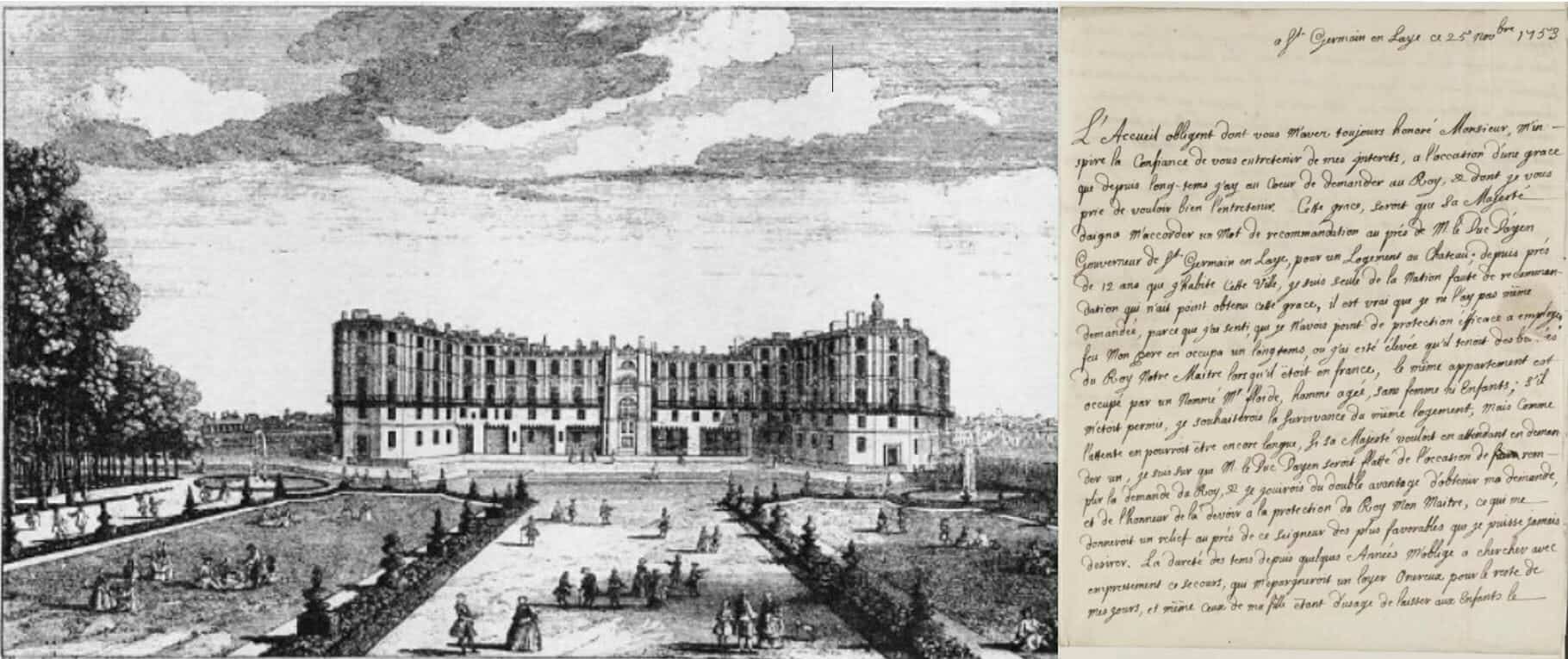│By Edward Corp, retired Professor of British History at the Université de Toulouse│
A couple of years ago I published a biography of Sir David Nairne.1 He worked in the political secretariat of the Stuart court in exile for thirty years (1689-1728), and the Stuart Papers contain a great many letters written by him or to him during that period. I read and used those letters, and also consulted a private diary that he kept during the first half of that period. Unfortunately the diary comes to an end in 1708, and there was one thing that I was never able to discover. It might seem unimportant in itself, but it is significant in the context of a biography.
When gaps in the sources leave a question unanswered
Nairne had to rent a house in the town of Saint-Germain-en-Laye, where the court was situated, and walk to work every day. But he wanted to be given an apartment within the royal château, so that he could actually live at the Stuart court. He had a French wife and several children, and renting a house in the town was expensive. The apartments in the château, however, were free. So he tells us in his diary that he repeatedly asked to be allocated one of them, but that each time he was disappointed. As the years went by he became more senior, and spent more time in conference with the exiled King James III, so his eligibility to get an apartment must have increased. But did he ever get one? I had no means of knowing as his diary, which would have told me, ends in 1708. All I knew is that he continued to live somewhere at Saint-Germain until the exiled king was obliged to leave France and took Nairne with him. So my biography was published leaving the question unanswered.
The Stuart and Cumberland Papers from the Royal Archives, Windsor Castle
Then the Stuart Papers became available online, opening up the possibility of doing more research – from home, without having to travel a long way and at great expense to consult the papers. So I wondered if I might eventually find the answer to my question.
I had already consulted all of Nairne’s letters written during his retirement, but one of his daughters corresponded with the king’s private secretary in Rome. Perhaps her letters would give me a clue. And sure enough, after a lot of research, I found what I wanted. In 1742 she and her husband Sir Andrew Ramsay (the Chevalier Ramsay) decided to rent a house in the town of Saint-Germain, but the following year Ramsay died and she was left widowed with much less money. So she, like her father before her, wanted to be given an apartment in the château. It no longer contained the Stuart court, but it was still full of Jacobite exiles and the apartments were still rent free. On 25 November 1753 she finally gave me the answer to my question. In a letter (RA SP/MAIN/345/1) written in French to the private secretary in Rome (James Edgar) she explained that she had wanted for a long time to be given an apartment in the château. She then explained that there was an old man, with neither wife nor children, who was living in the actual apartment which her father had once occupied and where she had been brought up. Might the king recommend that she be given the apartment when the man died? So there was my answer. At some point between 1708 and 1712 Nairne had finally obtained an apartment in the château.
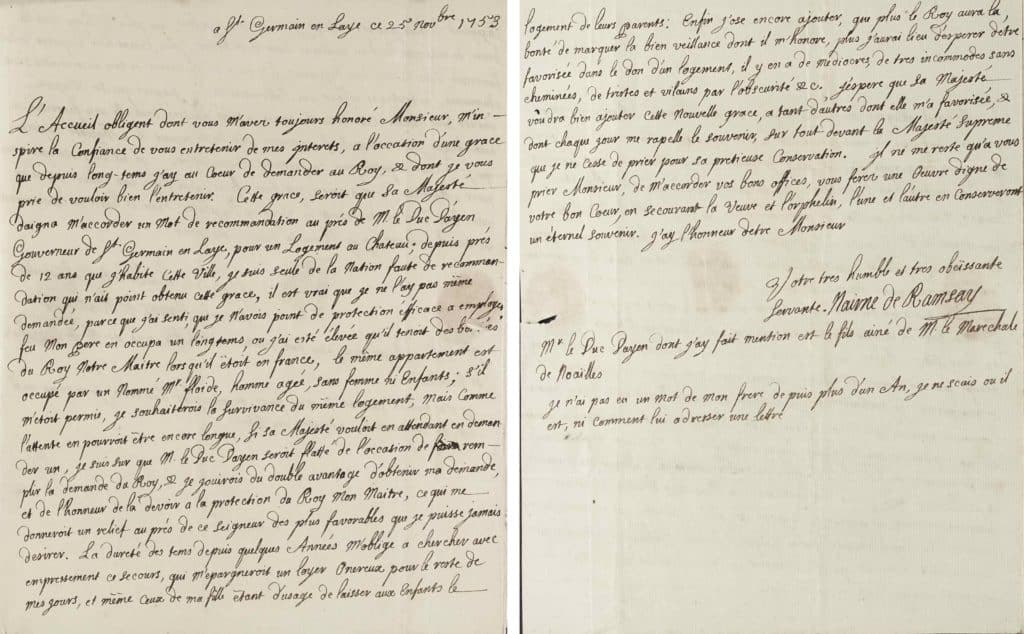
Letter from Marie Ramsay to James Edgar, 25 November 1753 (RA SP/MAIN/345/1 and 1a)
I quickly discovered where the apartment was, because there is a document at Versailles which records both the locations of all the apartments and the names of their occupants in the late 1730s. Nairne had been given the apartment immediately beneath what had once been the private inner rooms of King James II. He could easily walk a short way within the building to visit both the dowager Queen Mary of Modena and her son James III, with whom he was regularly in conference.
Nairne’s daughter, Lady Ramsay, moves to Sens
The Stuart Papers are full of personal details like this about the many Jacobite families living in exile, who they were, what they did, and their social conditions. The story of Nairne’s daughter, Lady Ramsay, gives us an example. She was disappointed and never did obtain her father’s old apartment, so she eventually found renting a home in the town of Saint-Germain to be too expensive. She then did what many other Jacobites did: in 1757 she went to live in the cathedral city of Sens, where renting property was much cheaper. She had a teenage daughter, but shortly after moving to Sens the girl contracted smallpox and died. Feeling isolated and lonely she decided to adopt a baby. And the child she adopted was a daughter of the 2nd Earl of Rosebery’s sister.
Lady Ramsay adopts an Earl’s grand-daughter
I have searched in vain for information about this Rosebery granddaughter, but the Stuart Papers do tell us why she was at Sens and why she needed to be adopted. Lord Rosebery’s younger sister Mary was married to Sir Archibald Primrose who was executed at Carlisle in November 1746 for having supported Bonnie Prince Charlie and the Jacobite rising. That much is perfectly well known. What no one else seems to have recorded is that their daughter escaped to France with her husband, a certain Mr Rolle, and went to live in a village near Sens. In 1760 Mrs Rolle gave birth to a daughter but then, for reasons unrecorded, decided to return to Scotland leaving the baby behind with her husband. Shortly afterwards, when the little girl was only fifteen months old, Mr Rolle died leaving the child orphaned in a little French country village. Lady Ramsay was sixty years old by then but saved the girl from being sent to a common orphanage, and persuaded the Archbishop of Sens to give her a pension to look after the child. Five years later she wrote to Bonnie Prince Charlie’s private secretary (Andrew Lumisden) that she loved the child as if it were her own (‘m’est aussi chere que si je l’eusse portée dans mon sein’: is as precious to me as if I had carried her at my breast) (RA SP/MAIN/434/26).
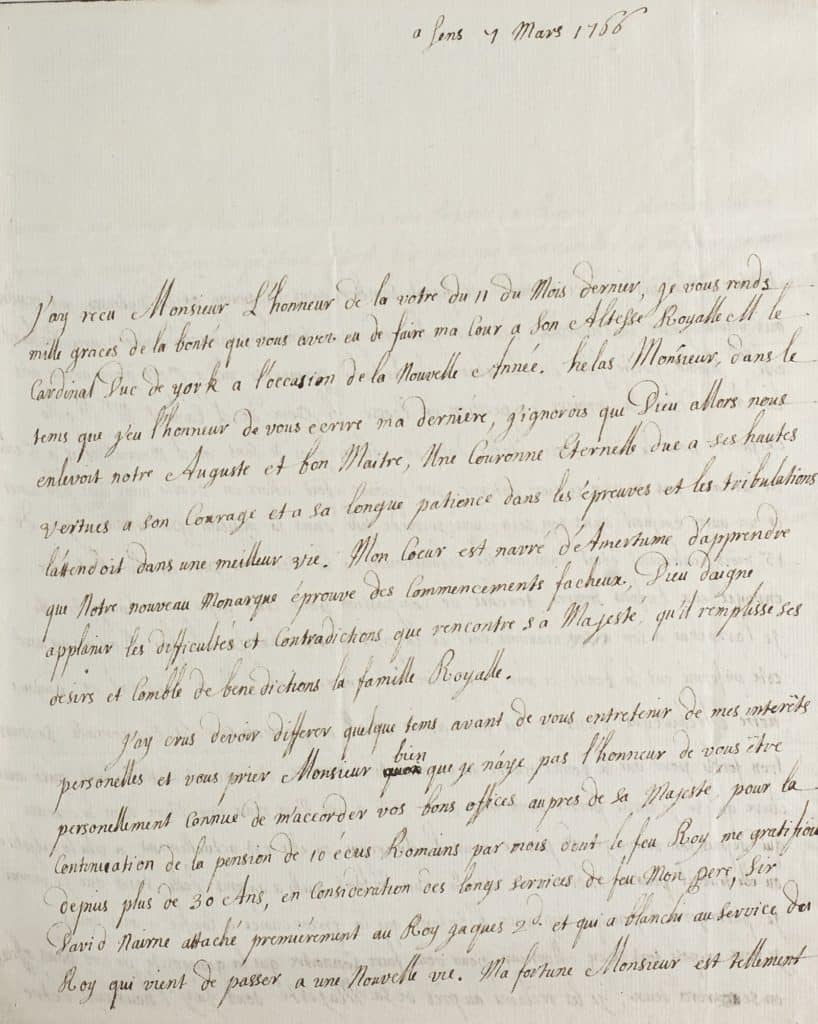
Letter from Marie Ramsay to Andrew Lumisden, 7 March 1766 (p.1) (RA SP/MAIN/434 f.26-27)
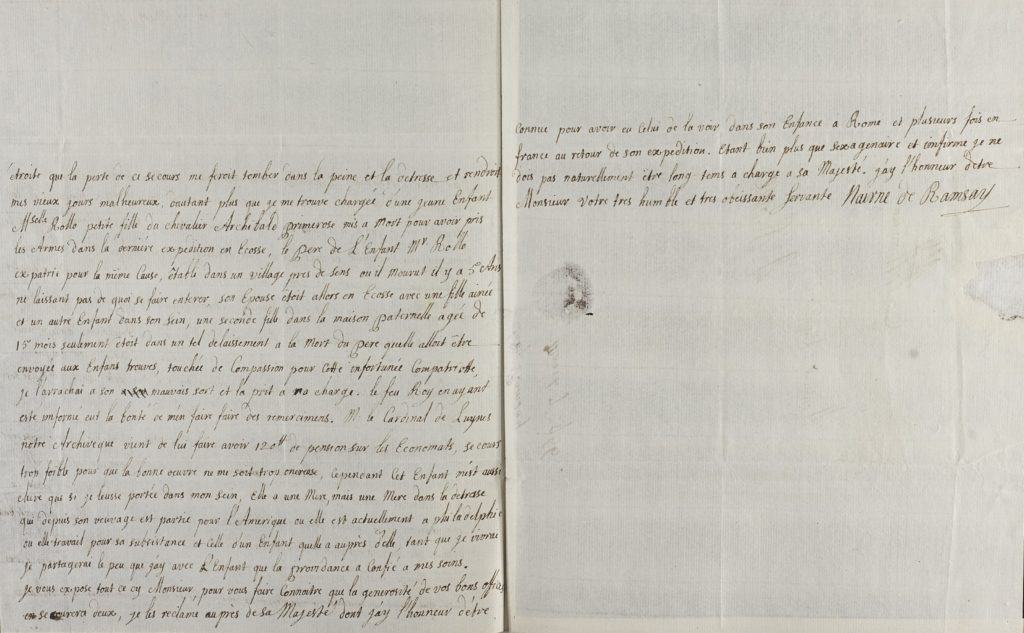
Letter from Marie Ramsay to Andrew Lumisden, 7 March 1766 (pp.2-3) (RA SP/MAIN/434 f.26-27)
Further family intrigue
What, one might ask, about the child’s mother, Mrs Rolle? When she had returned to Scotland she was pregnant again and had given birth to another daughter. As she was the niece of the 2nd Earl of Rosebery, and first cousin of the 3rd Earl (grandfather of the Prime Minister), she might have hoped to receive help from her family so she could return to collect her daughter in France. But that is not what happened.
Lady Ramsay’s letters in the Stuart Papers tell us that Mrs Rolle must have been disowned by her family, because by 1766 was living in Philadelphia with her younger daughter and working as a servant or perhaps a seamstress (‘elle travaille pour sa subsistence’: she works for her living) (RA. SP/MAIN/434/26).
Two years later she was still there (‘la mere de mon enfant est a philadelphie en amerique ou elle vit de travail de ses doigts’: the mother of my child is in Philadelphia in America where she earns her living by working with her hands) (RA. SP/MAIN/446/65).
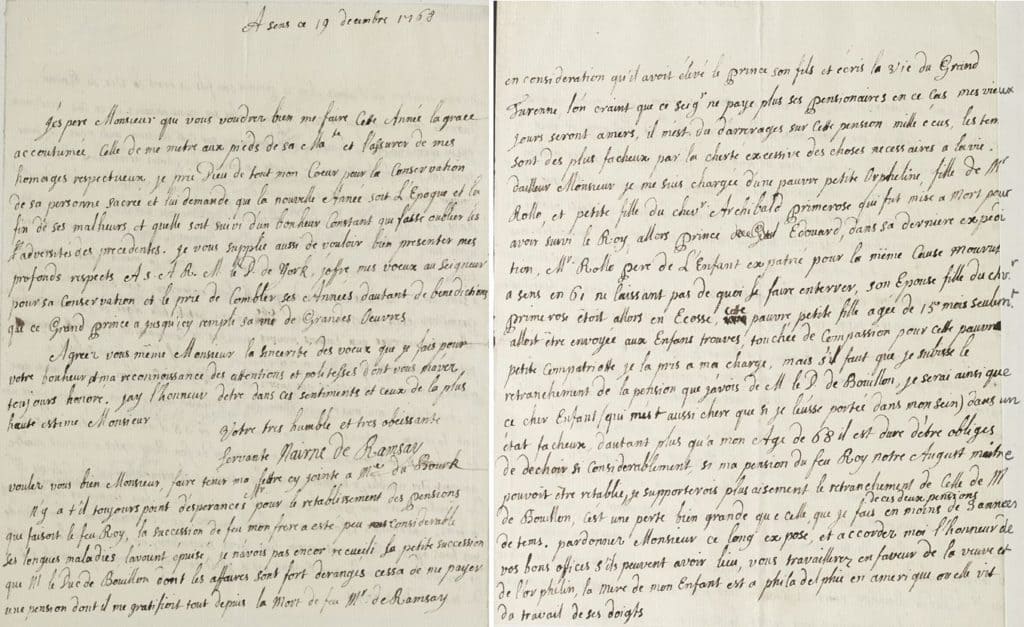
Letter from Marie Ramsay to Andrew Lumisden, 19 December 1768, pages 1-2 (RA. SP/MAIN/446/65-66)
I do not know what happened to the little girl whom Lady Ramsay had adopted. She would have been only sixteen when Lady Ramsay died in 1776. Nor do I know what happened to her mother and sister in Philadelphia. Was the family ever reunited? And did the Earls of Rosebery remember that they might have had cousins in France and Philadelphia? Perhaps we will find out one day. For the moment, however, it is enough to say that the Stuart Papers online contain a treasure trove for people researching the family histories of Jacobites who went into exile during the century after 1689.
Blog post cover image citation: Jacques Rigaud, Vue du Vieux Chateau de St Germain en Laye, engraving, 1725. (The royal apartments were on the second floor). And page 1 of Letter from Marie Ramsay to James Edgar, 25 November 1753 (RA SP/MAIN/345/1)

